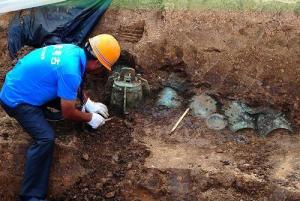Chinese archaeologists recently discovered several graves which are speculated to belong to the Western Zhou Dynasty (1046–771 BC) in Baoji City of northwest China’s Shanxi Province.
Most of the graves were robbed, but among the graves there is a rubble tomb believed to be a nobleman’s tomb.
The rubble tomb is 3.7 meters (12.14 feet) long, two meters (6.5 feet) wide and 1.3 meters (4.2 feet) buried under earth.
According to the buried artifacts and the hierarchy of the Western Zhou period, the tomb buried a senior government official.
“As we known, the Western Zhou period criteria to identify the identification and hierarchical title of the tomb owner is the amount of bronze tripods in grave. We found five bronze tripods and those five may be a set. According to the five bronze tripods, the owner of the tomb might be a senior official of nobility group,” said Sun Qingwei, deputy dean of School of Archaeology and Museology, Peking University.
The tomb was broken during robberies as it was under the riverbed, covered with rubble which protected it from being discovered, according to archaeologists.
Archaeologists found more than 37 relics of the Western Zhou period from the tomb, one of the biggest discoveries over the past 30 years.
“Currently, we have already classified 17 bronze vessels, more than 20 potteries,” said Sun.
The archaeologists estimated there are more than 30 tombs nearby.
 CGTN America
CGTN America
